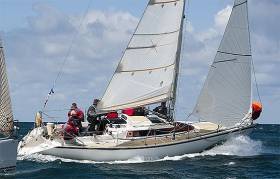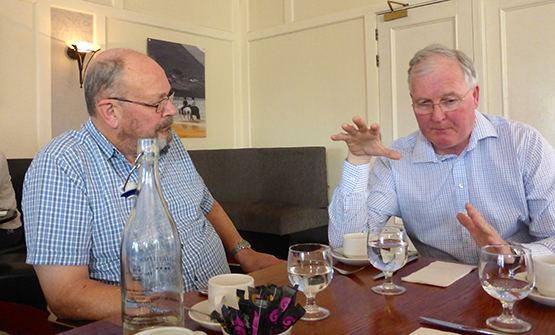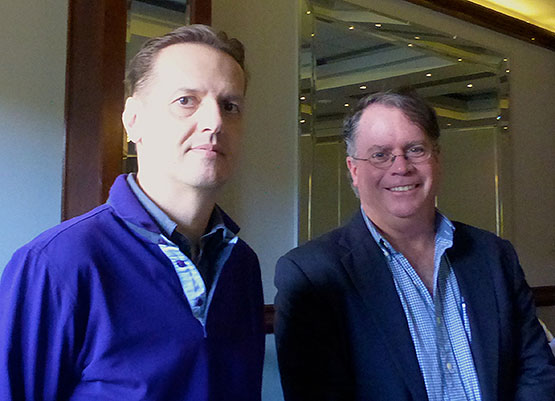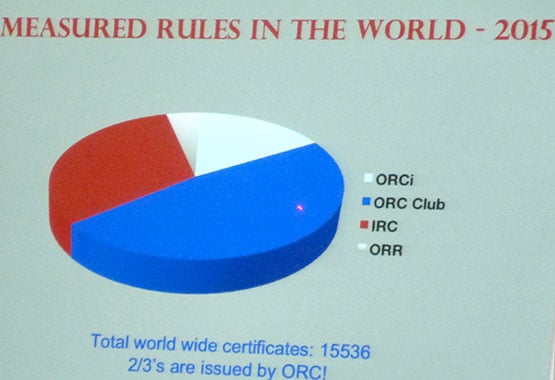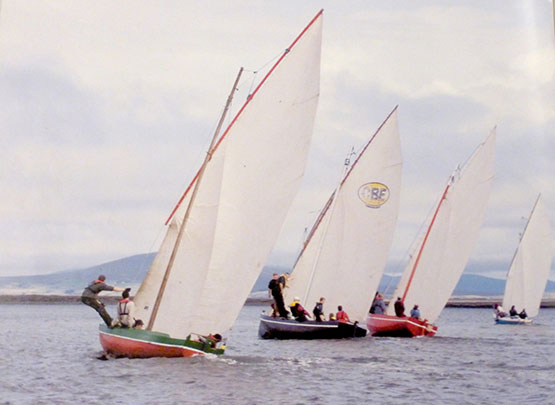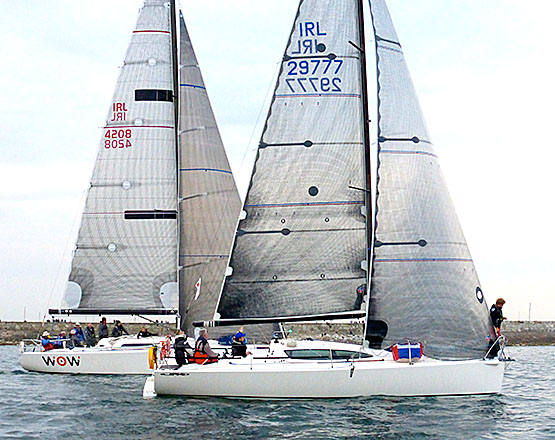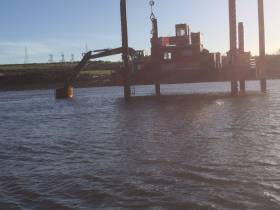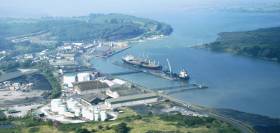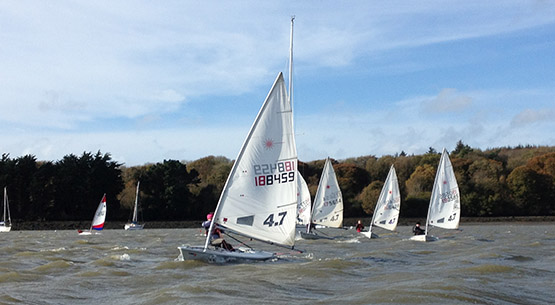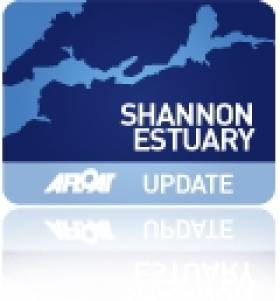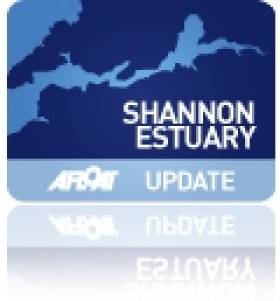Displaying items by tag: Shannon Estuary
The Irish Cruiser-Racer Association (ICRA) is a unique organisation. “Run by sailors for sailors”, it is nevertheless a very land-centric administrative body whose only manifestation afloat as a group with its own identity is seen at the organisation of the annual ICRA Nationals. And the sense of it relating purely to the island of Ireland is accentuated by the fact that much of its work is essentially back-office activity, dealing with handicaps and all the other paraphernalia involved in providing the nation’s numerous and very diverse cruiser-racer fleet with meaningful racing. W M Nixon went to last Saturday’s ICRA Conference to get a flavour of what ICRA does, and came away both impressed and stimulated.
Sweeping along southwestward towards Limerick on our wonderful motorway system, while one’s body stays firmly on the dual carriageway, the mind can wander into any pathways it wishes. So we got to thinking that, in this age of increasing numbers of administrators trained to third level degrees in the running of not-for-profit organisations, it’s a bit odd to find a very successfully central organisation which is apparently run – and well run at that - on a Corinthian basis “by sailors for sailors”.
Surely in today’s climate, which favours key bodies such as this being run by highly-trained specialists on at least a semi-professional basis, a seemingly amorphous organisation which is “run by sailors for sailors” is verging on a clear case of the asylum being taken over by the lunatics?
We’d soon see. Meanwhile, why on earth hold an annual conference in Limerick? With Ireland’s population distribution changing so rapidly, skewing both towards the large urban centres and particularly towards the east coast and Dublin, surely anyone organising a national conference would find it attendee-friendly to look at the latest map of population weighting. As it happens, I’m not sure that such a map exists, but we’d like to think that with today’s computers it is possible to construct a map where, after due calculation, you could pinpoint to the exact centre of Ireland’s total population distribution.
So you set out heading for Limerick at an unfeasibly early hour thinking that maybe a central location such as pretty Portlaoise or tidy Trim would probably be Ireland’s central point in relation to population distribution. But after some smooth time on the road with the sense of the wonderful west coast coming ever nearer, you begin to wonder why ICRA didn’t make a proper job of it, and take us to Dingle where we can breathe that wonderful Atlantic air and think great thoughts of sailing the high seas.

Far from the pressures of the cities of the east and south coasts, Dis-a-Ray is moored in the peaceful surroundings of Tarbert, where the south shore of the Shannon Estuary has already become part of the Kingdom of Kerry. Photo: W M Nixon
As it is, though the Dubs may think of Limerick as being on the western seaboard, it’s actually remarkably central when you draw lines across Ireland between all the best sailing locations. And as we knew that the position of Commodore of ICRA was going to pass on Saturday from Nobby Reilly of Howth (the Dingle of the East Coast) to Simon McGibney, Limerick was just about spot on in terms of equal travel time. For although the new Commodore has Foynes YC on the Shannon Estuary as his home club, his Dehler 101 Dis-a-ray is actually moored at his home at Tarbert which is further west down the Estuary, so much so that Tarbert is in the Kingdom of Kerry.
We arrived in to find a virtually full house distributed around a room-circling table such as they use for international diplomatic conferences to make peace with rogue states, with the layout being planned so that everyone can be an equal participant. It was grand for those of us who had arrived in the nick of time to get a seat, as we’d the fully-equipped table in front of us (did anybody else find it the devil’s own job to open the rather good but tightly-wrapped little sucky sweets which are essential to a talking shop?), but being Ireland several people arrived late, the show was already on the road, and they’d to find a seat as best they could.
All of which meant that there was a bigger turnout than expected, which is good news for ICRA. And for those of us comfortably ensconced, it made for a fascinating throughput of information by a long list of speakers, even though the layout meant that networking was restricted to the one hour lunch break if - like many people - you were relying on the 3.30-3.45pm wrap-up to facilitate returning to Dublin or Cork or wherever for a completely different event that night.
From the beginning, the dominant theme was on how we get more people into sailing, and everyone blithely talked as though we’re offering Joe Public a warm and sunny Croatian sailing product right here in Ireland, cheerfully ignoring the fact the last two summers have been plain lousy in terms of good weather.
Certainly the sailing was great for the enthusiast, but can you imagine a newcomer to the rough and ready sailing world wondering where on earth the attraction of it all was to be found as they were blown and bashed around at what we thought of as the utterly wonderful ICRA Nationals at Kinsale in June, or took in the all-too-typical variety of Irish summer weather at the hugely successful Volvo Dun Laoghaire Regatta in Dublin Bay in July?
Yet there is a fresh demand out there, and two of the morning’s speakers, Alistair Rumball of the Irish National Sailing School in Dun Laoghaire and Des McWilliam of McWilliam Sailmakers in Crosshaven, gave excellent talks on encouraging it, with Alistair showing us how his programme of moving beginners through dinghies and on into the school/club’s1720s, then became an inevitable progression into gaining experience and instruction on the school’s Prima 38 Lynx.
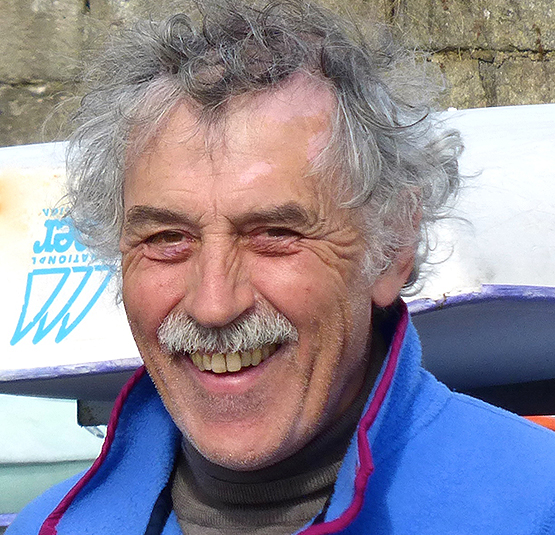 The mover and shaker. Alistair Rumball’s Irish National Sailing School in Dun Laoghaire is first port of call for many newcomers to sailing. Photo: W M Nixon
The mover and shaker. Alistair Rumball’s Irish National Sailing School in Dun Laoghaire is first port of call for many newcomers to sailing. Photo: W M Nixon
“Lynx has been a greater success than we could have ever dreamed of” he said. “She has been so booked out with people keen to learn about sailing a cruiser-racer that we haven’t been able to get as much actual racing with ISORA and so forth as we’d like. But for 2016, she’s being taken out of our Dun Laoghaire setup for long enough to be organised for a proper shot at the Volvo Round Ireland”.
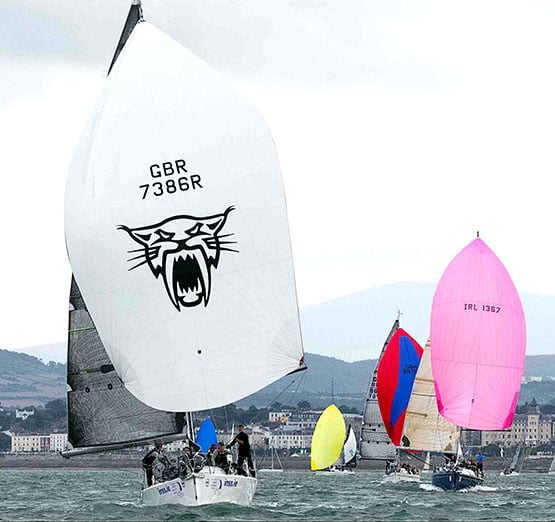
The double life of a Prima 38. The INSS’s Lynx in full racing mode in Dublin Bay (above), while below she is seen in early training mode as she takes a crew of beginners in cruiser-racing out for some formative experiences

As of last weekend in Limerick, there were just two crew places left aboard Lynx for this year’s Volvo Round Ireland on June 18th, and they’ve probably been snapped up by now. But the Rumball presentation underlined the fact that there are people out there who are mad keen to get into cruiser-racing, and it was up to ICRA to guide its members as to how best to tap into these wannabee sailors, instead of bleating all the time about how hard it is to find crew.
Des McWilliam leapt into the same theme, and gave us a crash course in how to make crewing on your boat more attractive to strangers. Admittedly the experience of seven years of acute economic recession have understandably made those who have kept boats in racing commission more than a little stressed. But if they want to reap the benefits of having struggled to stay in the boat-owning stream, then they have to make their cruiser-racers pleasanter to sail on, and more effective racing machines.
The McWilliam message was blunt in the extreme. “As a sailmaker in Ireland, each year I will race actively at many venues on upwards of 40 boats, both evenings and weekends. I will experience many different management and sailing styles. At the end of the year looking back, I usually realise that there might be only ten to a dozen boats out of that total of forty to which I would gladly and freely return for the good sport, the efficient sailing, the successful racing, the camaraderie – the fun. The rest of them are just work, involving duty visits. Please remember this when you are setting up the running of your boat, and trying to encourage people to sail with you.”
Des McWilliam of Crosshaven and Rory Staunton of Mayo. Des provided the meeting with some telling home truths about how attractive (or not) cruiser-racers throughout Ireland can be to sail on, while Rory Staunton led the charge in wondering why ORC and IRC cannot be amalgamated, and then went on to outline a new trailerable 33-footer he and an international group of friends are developing to make the incomparable west of Ireland a more accessible sailing area
We earned our lunch by going through an intensive session with Dobbs Davis of the Offshore Racing Congress, who had come to the conference with Zoran Grubisa to promote their measurement rule, which is used worldwide anywhere that IRC is not dominant, and in some key events such as the Rolex Sydney-Hobart Race, they are used in tandem, though IRC is currently the more-used system in that classic event.
It says everything about how Irish sailing punches way above its weight that these two guys thought it worth their while to come among us and evangelise for their system in a country which has a more-than-friendly relationship with the IRC and the people who run it. But it was fascinating stuff, making an input which added real spice to the day.
Davis is Chairman of the ORC’s Promotion & Development Committee, while Grubisa heads the Rating Officers Committee, and they run a system which is now the ISAF-approved rating method for the ISAF Offshore Worlds, which this year will be staged in Copenhagen in July, which as it happens is more or less the same time as the Royal Cork YC will be staging the new European IRC Championship in Volvo Cork Week at Crosshaven.
So the presence of the evangelists from the ORC at the ICRA conference could have opened up a right can of worms, but fair play to Dobbs Davis, he gave such an enthusiastic and lucid explanation of the completely transparent way in which ORC function that, for the time being at least, one’s instinctive loyalty to IRC was suspended out of intellectual curiosity.
Leading Offshore Racing Congress officers Zoran Grubisa (left) and Dobbs Davis were in Limerick to evangelise for the ORC Rating system
While IRC still has one or two hidden elements – the “Black Box” factor – with the transparency of ORC, you can always see how different inputs are effecting the final figure. One-design sailors may find all this utterly yawn-making, but as Davis pointed out, although there are so many successful cruiser-racer One-Design classes in America that ORC has yet to gain significant traction there despite being first set up in the US forty years ago, elsewhere in the world more and more people are coming to ORC as they enjoy watching boat innovation and performance analysis interacting to make their sailing more interesting and the results indicative of pure sailing ability.
The approachability of the ORC system was presented as one of its advantages
The slice of the cake worldwide for the different rating systems
But as we all know, where IRC and OCR are run side-by-side, despite the IRC’s hidden elements the two outcomes are often very similar. And in Ireland where we have a soft spot for the old S&3 34s which set world alight in 1969-73, the fact that the veteran though beautifully restored S&S 34 Quikpoint Azzura was overall winner of the Rolex-Sydney Hobart Race under OCR, after so nearly doing it on IRC, caused a bit of heart-searching. But nevertheless Rory Staunton from Mayo SC spoke for many when he demanded to know why IRC and ORC couldn’t get together and resolve their small differences for the general benefit of the offshore racing fraternity. Dobbs Davis said his door was always open, but that began to feel a bit too reminiscent of the current efforts to form a government, so we were glad enough to take a break for lunch and then return to the rating topic, but from an entirely different point of view
The inevitable expense in maximizing your boat’s performance potential under either IRC or ORC made the sheer economy of ICRA’s Progressive ECHO system seem immediately attractive, and the lead-in the afternoon session by SCORA Commodore Ronan Enright even more apposite. Because the fact is, you could run the Progressive ECHO Handicap System without even knowing what a boat looks like, let alone having her dimensions measured do the last millimtre.
Donal O’Sullivan of Dublin Bay SC, and Ronan Enright, Commodore SCORA, discussing sailing administration matters during the lunch break at Limerick. Enright went on to give an illuminating presentation about developments in Progressive ECHO Photo: W M Nixon
In the absence of ICRA’s ECHO supremo Denis Kiely - unavoidably absent for family reasons – Ronan Enright gave a quietly telling performance. It’s fascinating that though ECHO started life as the East Coast Handicap Organisation back around 1971-72, it’s now a nationwide service overseen by ICRA, and its most active area of development is in the cauldron of concentrated cruiser-racing which you find when the activities of Cork Habour and Kinsale are combined.
Basically, Progressive ECHO depends on the results of the most recent race, after which, if certain criteria have been fulfilled, the results are automatically re-computed to give boats a new rating based the supposition that they had all finished dead level on handicapped time. My own most recent experience of racing with it when it is being enthusiastically applied was in the Volvo Dun Laoghaire Regatta, which was a perfect test-bed for the system, as it was a compact series with the same fleet throughout.
The result is a series-long level of commitment by boats and crews who, under a more brutal system, would have seen their interest and enthusiasm flag after Day Two or even earlier. So really the message is: If we’re trying to get people to enjoy sailing and particularly to enjoy racing which is what the non-involved most easily comprehend, then Progressive ECHO is doing more to get bums on boats than anything else in Irish sailing, for believe me you have never seen anything quite so heart-warming as the response of a crew who, under One-Design or fixed handicap systems, had not been at the races at all, yet suddenly under Progressive ECHO they find they’ve recorded a win.
Which was all good news but perhaps the most interesting revelation of all from Ronan Enright was that the top IRC racers around Cork are now taking a closer interest in their Progressive ECHO showing than there are in their IRC results. For under IRC, they know they’ll be in the top six, but each post-race adjustment of Progressive ECHO gives them a very clear message about just how well or not they were really doing on the day.
Tom MacSweeney of this parish then hosted a forum which basically came down to how sailing can present a more friendly and accessible response to people who might be vaguely interested, and could be potential sailing enthusiasts. This involved him drawing on his training as a critical journalist, for as he admitted, when he first turned up with his first sailing boat – a Ruffian 23 – in Crosshaven, everyone from Denis Doyle downwards immediately made him welcome. But we can all think of non-assertive characters who are great sailors, yet if they hadn’t been in sailing families in the first place, they might not have taken up the sport at all owing to the sometime apparently closed nature of “yachting”.
We learned that very little of an Achill yawl is showing above the water after she capsizes. This is how they look in proper order
Allied to Des McWilliam’s incisive look at boats which you like to be aboard, and boats which you definitely don’t, and it all provided food for thought, as too did John Leech of Irish Water Safety with his no-nonsense presentation about a mature approach both to safety, and to being rescued. In an interesting mix of images, he showed us a photo of what happens to an Achill yawl when it capsizes. The result is an awful lot of rather waterlogged traditional boat under the surface, and only a little bit showing with the crew perched on top. As Des McWilliam was probably the only other person present with any idea of what an Schill yawl in full health looks like, the least we can do here is show you a photo of them in good sailing order. Meanwhile, John Leech concluded by saying that when you call out the ASR helicopters, think rather of how you can prevent your mast – if it’s still standing – from interfering with the rescue. Don’t for heaven’s sake use up emotional energy thinking about how much it all costs. They’re on standby all the time, and you the taxpayer have paid for them in the first place.
We concluded with Rory Staunton seeking interest and opinions for the new 33ft trailerable One-Design. While we all hope to get down to Clew Bay to sail the prototype this summer, could I suggest that one of the most exciting projects on the Irish cruiser-racer horizon is WIORA Week 2017 in the Aran Islands. So when they’ve finally got around to fixing a date, maybe the promoters of the new 33-footers could arrange to have a flotilla of them in Kilronan in 2017 to give the class a rocket-assisted launching.
Meanwhile this year’s WIORA West Coast Championship is under the auspices of the Royal Western of Ireland Yacht Club at Kilrush from June 29th to July 2nd. There’s so much extraordinary history in being able to write that simple bit of information that I reckon we’ll have to give it a complete blog in the future.
As for the ICRA Nationals, they’re at Howth from June 10th to 12th with both IRC and Progressive ECHO being used, while Volvo Cork Week comes up in July after the Volvo Round Ireland race has been tidied away in late June.
Although last Saturday’s Limerick gathering was essentially a wide-ranging conference, it was also the changeover to the new Commodore, with Simon McGibney taking on the mantle from the energetic and enthusiastic Nobby Reilly whose own boat, the Mills 36 Crazy Horse, was seen in virtually every event, and looked like heading for the win in Class at the ICRA Nats in Kinsale last June until new big winds swept George Sisk’s WOW to the fore. During Nobby’s busy time in the top office, ICRA’s activities and its reach steadily expand, while thanks to the persuasive efforts of Anthony O’Leary, a Commodore’s Cup team was assembled which regained the trophy in 2014.
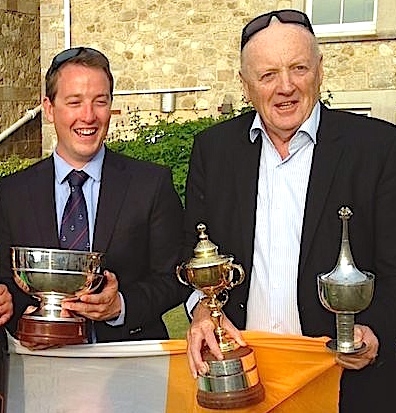 Ross MacDonald and ICRA Commodore Nobby Reilly at the Royal Yacht Squadron in Cowes in July 2014 after Ireland had won the Commodore’s Cup. At the ICRA Conference in Limerick last weekend, McDonald won a special award for his season’s results in 2015 with his X332 Equinox, while Nobby Reilly stood down after his successful years as Commodore, handing over the helm to Simon McGibney.
Ross MacDonald and ICRA Commodore Nobby Reilly at the Royal Yacht Squadron in Cowes in July 2014 after Ireland had won the Commodore’s Cup. At the ICRA Conference in Limerick last weekend, McDonald won a special award for his season’s results in 2015 with his X332 Equinox, while Nobby Reilly stood down after his successful years as Commodore, handing over the helm to Simon McGibney.
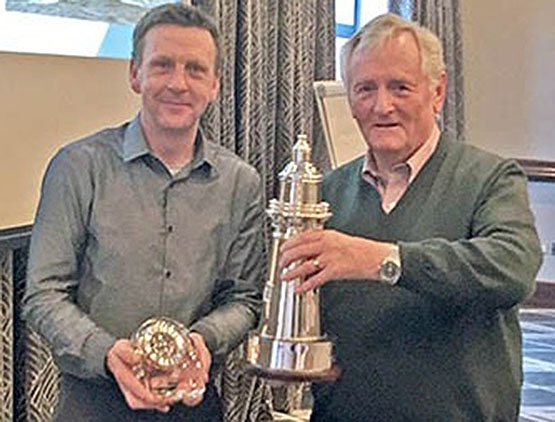
New ICRA Commodore Simom McGibney presents the “Boat of the Year” trophy to George Sisk of the Royal Irish Yacht Club, skipper of the Farr 42 WOW.
Work is going on behind the scenes to provide a strong defence this summer, but Anthony O’Leary wasn’t in Limerick to tell us about it, as he was away on his annual participation in America in the Viper 640 Championship, which just wouldn’t be the same if O’Leary wasn’t taking part - so much so that last year, he wasn’t present when his name came up as “Sailor of the Year” in Dublin, for he was away then too, Viper racing in the sun.
But other top sailors were there to round out the conference with the annual awards such as special performances by the likes of Dave Cullen with Checkmate XV and Ross Macdonald with Equinox and, while the ICRA Boat of the Year presentation, with warm acclamation, went to George Sisk of WOW, who not only admitted that his well-tested craft usually races with a crew of average age 53, but if he himself didn’t happen to be on board, the average age came down considerably………..And in case you think becoming ICRA Boat of the Year is all about glamour racing in sunshine, we close with a photo of WOW and the JPK 950 Alchimiste crawling towards the starting line for the Dun Laoghaire to Dingke race on the sort of damply windless evening that most folk would much prefer to spend comfortably at home.
It isn’t always glamour and warm sunshine and pleasant breezes. 2015 ICRA Boat of the Year WOW on a damp and windless evening approaching the start of the 280-mile Dun Laoghaire to Dingle race with the JPK 960 Alchimiste.
Foynes Yacht Club Laser Fleet Expands
It’s feast or famine with the wind these days at Foynes Yacht Club and after being blown out last weekend the possibility of getting a final days racing in the Reidy’s Centra Laser and Topper Series wasn’t looking promising as for much of the morning the River Shannon looked more like a sheet of glass than a sailing venue.
Racing was postponed until shortly after 1pm to allow the forecasted 8-10kts to build. The laser fleet continues to expand with another new junior sailor, Clara Shanahan, joining the racing today. OOD Vincent McCormack unusually brought the fleet west of Foynes Island which paid off as a nice breeze filled in albeit from the north and not SE as forecast and the race team managed to get in two windward-leeward races to conclude the series. The Junior Category was won by Dylan Reidy and the Senior Category by Cathal McMahon. Dinghy racing will continue next weekend with the March Laser and Topper Series starting next Sunday, 6th March.
Earlier this month four of Foynes newest and youngest boat owners took part in the week long optimist training camp in Baltimore. This is first time the club have had members taking part and the young sailors had a great week. Fresh with enthusiasm from the camp the oppie sailors, the fleet now up to six, took to the water to try out their newly acquired knowledge and skills. The future of the club is in good hands with these young sailors who fought off the cold with brave smiles for three very competitive races.
While winter projects continue in the yard the clubhouse is also getting plenty of use. This weekend the ISA had organised a Race Officer Level One Course at the Foynes venue. The course was given by National Race Officer Geoff O’Donoghue from Lough Derg Yacht Club and had a huge attendance with over 30 members from seven clubs along the west coast and the lakes taking part.
Next Saturday, 5th March, the Irish Cruiser Racing Association annual conference takes place in Limerick. The club are very proud to see one of their own members, Simon McGibney, take over the role of ICRA Commodore and would like to wish him every success in his tenure. The conference is on in the Castletroy Park Hotel from 10am and all cruiser sailors are welcome.
Shannon River Crossing Project to Install High-Voltage Cable
#Project - The "Shannon River Crossing" project is currently underway to install a high-voltage submarine cable linking counties on either side of the river.
The project conducted by ABCO Marine (Irl) Ltd aims to provide electricity between Kilpaddoge, Co Kerry and Moneypoint, Co Clare across the opposite banks along an underwater route of approximately 3km.
The project invloves the supply, installation and commissioning of a High Voltage Alternate Current (HVAC) comprising 21km of submarine cable. ABCO have mobilised the C57 Red Squirrel Jack Up Barge and workboats to support the marine trench excavation operations in support of the Kilpaddoge cable landings.
Currently ABCO's marine personnel, including support from ABCO Divers Ltd are on site completing the cable protection and marine trench backfilling operations. The site is challenging with significant tides as well as strong tidal currents, with all activities programmed and risk managed to maximise productivity whilst maintaining the highest H&S standards.
Commenting on the project, Brendan Osborne, ABCO's Marine Director, said: "We mobilised to the project in December to support the cable installation and marine trench excavation, the seasonal factors place increased risk on marine operations.
Our site team have excelled in the delivery of our operations to the clients satisfaction in a challenging and demanding work environment”.
Shannon Foynes Turnaround as 2015 Tonnages at Almost Peak of Last Decade
#ShannonGrowth - Tonnage growth at Ireland’s largest bulk port, Shannon Foynes Port Company (SFPC) revealed that the 2015 throughput was almost back to the peak of the last decade and this is evidence of the recovery taking hold in the regions.
SFPC handled just over 11.1m tons in 2015, up from just over 10.1million in 2014, and this comes off the back of a €2.8m profit recorded in its most recent annual accounts, for 2014. Tonnages in 2015 saw the company, which operates six ports on the Shannon Estuary and facilitates international trade valued at over €6bn, almost return to peak levels (11.35m tons) in 2006.
Announcing 2015 tonnages this week, SFPC said that the company is achieving the growth targets revealed three years ago with the launch of its masterplan, Vision 2041, and that this reaffirms the need for major investment in road and rail infrastructure to ensure its potential can be maximised. The tonnages also copper-fastens the company’s position as the largest dry bulk port in the country.
Cargo volumes last year at the SFPC general cargo terminals at Limerick and Foynes were particularly robust with 10.73% year on year growth. Among the key growth sectors were petroleum products tonnages, which increased by 7.4% and cement exports, which rose by over 200%. Agri related cargo also grew steadily, with trades such as fertilisers increasing by over 4%.
SFPC CEO Patrick Keating said, “This growth reflects the resurgence in the domestic and export economy and, of course, in our own business. SFPC is a really good economic indicator for the region. We had some challenging years but the turn-around in our business has been remarkable, to the extent that we are now almost replicating tonnages from the height of the last decade and expect to surpass those levels over the coming years.
“We are very confident about the potential of the Shannon Estuary as a major economic engine room for this region thanks to its unrivalled natural water depths. This year alone we have completed the biggest investment in quayside infrastructure in any Irish port so far this decade with the infill of our East Jetty, as part a wider €50m capital spend at Foynes. Our investment programme is also attracting significant private interest, with €40m in private investment also now coming on stream.”
SFPC Chairman Michael Collins also commenting on the port performance said, “SFPC is proving one of the great success stories of the recovery in this region. This impressive turnaround is very much down to a dynamic team and its determination to deliver the robust but attainable targets we have set for the company.
“Last year was another very solid year in terms of traffic throughput but future growth can only be sustained by delivering additional capacity and putting the road and rail infrastructure in place. If this doesn’t happen, the company’s potential to be a major engine for growth in this region will be curtailed.”
'Unprecedented Opportunity' for Shannon Foynes Port As Trade Hub
#FoynesPort - An “unprecedented opportunity" for Foynes Port and the Shannon Estuary to become a centre of international trade with the potential for up to 3,000 jobs in the coming years, reports The Limerick Leader.
That is according to MEP Sean Kelly who is urging the European Union to recognise the port’s strategic importance.
The Fine Gael MEP recently attended a meeting in Brussels with port company chief executive Pat Keating and the European Commission’s Mobility and Transport Directorate.
“Shannon Foynes is one of a limited number of terminals with deep water facilities in Europe - facilities that no other Irish port enjoys. With the Panama Canal set to double its capacity in 2016, there is an unprecedented opportunity for Europe and for Ireland to capitalise as Shannon Foynes can cater for the huge new vessels that will be coming through,” said Mr Kelly.
To read more about the mid-western seaboard port, click here.
Kilrush RNLI Launch in Gales to Assist 43ft Motor Vessel
Kilrush RNLI Lifeboat crew on the Shannon Estuary launched early this morning in gale force conditions to assist 43ft motor vessel that had fouled its propeller south of Moneypoint.
At 4.59am Shannon Coast Guard tasked Kilrush RNLI volunteer lifeboat crew to assist a motor vessel with 3 people on board that had lost engine power due to its propeller becoming fouled.
Kilrush lifeboat crew reached the scene at 5.20am and assessed the situation. It was apparent that the motor vessel was heavily fouled and in no immediate danger of drifting. Commercial divers were tasked as the sea state improved and managed to clear the propeller. Kilrush RNLI stood by until power was restored to the motor vessel and returned to station at 7.10am.
Commenting on the callout, Charlie Glynn, Kilrush RNLI Lifeboat Press Officer said: ‘Weather conditions were challenging but our volunteer crews are well prepared for every eventuality. This is a testament to the level of training and commitment from all at Kilrush RNLI.’
First Dividend Paid by SFPC Amid Record Profits
#FirstDividend - Enjoying its biggest ever profits last year, Shannon Foynes Port Company (SFPC) has revealed from their 2014 annual report.
SFPC, which operates six ports on the Shannon Estuary and handles international trade valued at over €6bn, saw profits increase to €2.864m from €2.825m in 2013.
The company’s general cargo terminals recorded year-on-year increases of 5 per cent and capitalised on the recovering economy through a GDP growth of over 4 per cent for 2014.
The growth now means the company is in a position to provide a dividend from the 2014 results. For more on the story, The Sunday Business Post reports here.
Foynes Yacht Club Reports a Busy October on the Shannon Estuary
For the first time in its fifty three year history Foynes Yacht Club ran an ISA Go Racing course at the club during the school October mid-term break. The course was fully booked out with ten participants from Foynes Yacht Club, Dingle Sailing Club, Cullaun Sailing Club and Lough Derg Yacht Club who gave up their mid-term break lie-in to complete the course under the guidance of club racing instructor Tadhg O’Loingsigh and two senior Instructors, Simon McGibney from Foynes Yacht Club and Feidhlim O’Briain from Dingle Sailing Club. The weather was ideal for the course with the participants getting afloat every day in conditions varying from 5 knots to +25 knots. The junior sailors also had opportunities to hear from Graham Curran from UK McWilliam Sailmakers and international race officer Jack Roy, both of whom visited the club during the week. Foynes Yacht Club's Sailing Academy Principal Patrick Finucane said that the sailing academy has been striving towards this for a number of years and was delighted with the success of the course.
The cruiser October series took place during the month with a six race series and fourteen boats taking part. Racing took place over five weekends concluding on the final Saturday in October. The series started in beautiful sunshine with 10-12kts westerly where OOD Vincent McCormack set the fleet off with an interesting spinnaker start and following a course round the cans on the estuary. The next few week’s courses returned to beat starts either round the cans or windward leeward. Conditions were mixed, always sunshine, but winds anywhere from 5kts to 15kts, the lighter conditions presenting quite a challenge to anyone eager to get ashore on time for the rugby matches! Congratulations to the winners 1st Maximus from FYC, 2nd Scorpio Junior from Lough Derg, 3rd Powder Monkey from TBSC.
Junior and senior competitors after the ISA Go Racing course
The Laser and Topper fleet are back on the water again for the winter starting with a very successful October Series with nineteen boats taking part over the five weekends and nine out of the ten scheduled races taking place. Congratulations to the series winners in the senior fleet 1st Simon McGibney, 2nd Mark McCormack, 3rd Michael McGowan and in the junior fleet 1st Dylan Reidy, 2nd Mary McCormack, 3rd Oisín Finucane. The Laser and Topper November Series will begin next weekend and run on Sunday afternoons for the next four weeks.
#foynesairshow – One of the largest search and rescue (SAR) training exercises ever undertaken in Ireland will open the 2015 Foynes Air Show on Sunday, 26th July.
The Irish Air Corps, Naval Service (LÉ Samuel Beckett), Irish Coastguard, and Search and Rescue teams from all over the country will carry out their annual exercise in front of the estimated 15,000 people expected to attend the second annual air show.
Hosted by Foynes Flying Boat & Maritime Museum, the Air Show will also feature aircraft displays from across Europe, along with some of the world's top aerobatic pilots.
Among the aircraft taking to the skies over West Limerick and the Shannon Estuary will be a Russian Mini MiG, authentic World War Two aeroplanes, a Hawker Hunter fighter, a P51 Mustang and James Bond's BD-5 Micro-Jet. Meanwhile, Aer Lingus' first plane, the Iolar, will be flying in formation for one of the first times ever at a public display with three de Havilland Chipmunks in Air Corps colours.
The Air Show will also feature the world's only formation wingwalking display team, The Breitling Wingwalkers who will perform a sequence of formation loops and rolls while wingwalkers perform acrobatics on the wings.
The Air Show, which gets underway at 1pm and continues until 6pm, will also feature live music, food stalls and children's entertainment. Organisers say that Park and Ride services will be provided throughout the event to enhance access to and from the Air Show site
The Foynes Air Show was first held in 2014 when the Foynes Flying Boat & Maritime Museum marked the 75th anniversary of the first transatlantic commercial passenger flight that took place to the Flyingboat base, located 23 miles from Limerick City.
"We look forward to hosting a thrilling and exciting Air Show of an international standard which will feature even more aircraft and participants than our hugely successful inaugural show in 2014," commented Margaret O Shaughnessy the Director of Foynes Flying Boat & Maritime Museum.
"Foynes has a strong association with international aviation and has the world's only Flying Boat Museum featuring the world's only replica of B314 flying boat. The Air Show not only provides a wonderful day out for aviation enthusiasts and people of all ages but it also celebrates Foynes' historic place in world aviation history," she added.
Gerry Humphreys, Foynes Air Show Director said: "We are very excited to bring this free air show to Foynes again this year. We would like to thank our many sponsors without whose support this event would not be possible."
Aircraft taking part in the 2015 Foynes Air Show include:
Cold War Russian Aircraft - The Somerset-based Yakovlevs will perform a specialist airborne display team flying authentic cold war Russian war-bird aircraft in precise combinations of tight formations and aerobatics, high-speed passes and crosses.
BD5 - Made famous in the opening sequence of the James Bond film, Octopussy, the BD5 is a single-seat homebuilt aircraft created in the late 1960s by US aircraft designer Jim Bede
Sukhoi Su-26 - A single-seater aerobatics plane from the former Soviet Union, flown by ond of Ireland's top aerobatic pilots and engineers Dave Bruton
Hawker Hunter - A UK jet fighter flown by highly experienced former RAF Harrier pilot and Airbus Captain Andy Hill
Christen Eagle - Described as a true sports car of the sky, the 2-seat Eagle flown by Andrew Fenton will perform aerobatics
CAP 231 – Top Aerobstic Pilot Eddie Goggins "The Flying Dentist" returns to Foynes to fly an aircraft designed for competition aerobatics
Aviatika-MAI-890 (Mini-MiG) – 21 year old Pilot Harry Humphreys will fly his Aviatika-MAI-890, a pod-and-boom, pusher configuration biplane designed and built by the Moscow Aviation Institute (MAI) in Russia in the 1980s
RV4/8 - UK-based Team Raven will perform a 5-ship RV4/8 Aerobatic formation display
Vans RV7 - Gerry Humphreys and Eddie Goggins, known collectively as AerDynamics, are the first ever Irish civilian aerobatic formation team and will be flying the versatile Vans RV7 and the Cap 231 in a unique display of low level formation aerobatics and exciting head-on passes.
Killorglin based Approved Productions are the event managers for the upcoming Air Show, which is being supported and sponsored by Limerick City and County Council, The Irish Aviation Authority (IAA), Avolon, Wild Atlantic Way, Shannon Foynes Port Company, Irelandia Aviation, AerCap, Air Contractors, Rusal Aughinish and CPL Fuels.
EU Funding of €3m to Drive Shannon Foynes Masterplan
#EUPortFund - Funding of €3m from the EU has been secured for Shannon Foynes Port Company, the bulk of which will be spent on building a new East Jetty at the Limerick port, writes The Limerick Leader.
But some €800,000 has also been assigned to examine the feasibility of restoring the rail link to the facility. The East Jetty and the restoration of the rail link are part of the port company's 30-year master plan, Vision 2041. Earlier this year, a seven-year investment plan of €50m got underway and work began on developing the East Jetty which is expected to cost €12.5m.
The €3m funding has come under the Connecting Europe Facility, which has rolled out a record €13.1 billion investment plan for 276 transport projects across Europe. The port company was one of some 700 applicants for the fund and invested considerable time and effort in making the application.
The work on the East Jetty will completed in two phases. The first phase, which has begun, will involve the construction of a retaining wall along berth six, the removal of the existing viaduct and the infilling of 14,500 square metres behind berth six to create substantial new open quay storage.
Preliminary work will also take place on phase two, which involves linking the East and West jetties but construction of phase two is not expected to begin until 2019. The company has repeatedly made clear that it sees the restoration of the rail link as important for the continuing and future development of Foynes and of the estuary generally.
For more on the story click here



























